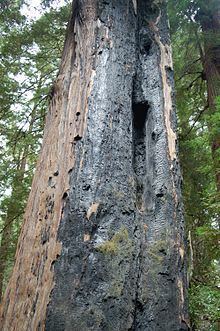 | ||
Representative species Quercus suber, Giant sequoia, Asphodelus albus | ||
Pyrophytes are plants which have adapted to tolerate fire. "Pyrophyte" comes from the ancient Greek "pyros" (fire) and "phytos" (plant).
Contents
Fire acts favorably for some species. "Passive pyrophytes" resist the effects of fire, particularly when it passes over quickly, and hence can out-compete less resistant plants, which are damaged. "Active pyrophytes" have a similar competing advantage to passive pyrophytes, but they also contain volatile oils and hence encourage the incidence of fires which are beneficial to them. "Pyrophile" plants are plants which require fire in order to complete their cycle of reproduction.
Passive pyrophytes
These resist fire with adaptations including thick bark, tissue with high moisture content, or underground storage structures. Examples include:
For some species of pine, such as Aleppo Pine (Pinus halepensis), European Black Pine (Pinus nigra) and Lodgepole Pine (Pinus contorta), the effects of fire can be antagonistic: if moderate, it helps pine cone bursting, seed dispersion and the cleaning of the underwoods; if intense, it destroys these resinous trees.
Active pyrophytes
Some trees and shrubs such as the Eucalyptus of Australia actually encourage the spread of fires by producing inflammable oils, and are dependent on their resistance to fire which keeps other species of tree from invading their habitat.
Pyrophile plants
Other plants which need fire for their reproduction are called pyrophile.
The passage of fire, by increasing temperature and releasing smoke, is necessary to raise seeds dormancy of pyrophile plants such as Cistus and Byblis an Australian passive carnivorous plant.
Imperata cylindrica is a plant of Papua New Guinea. Even green, it ignites easily and causes fires on the hills.
